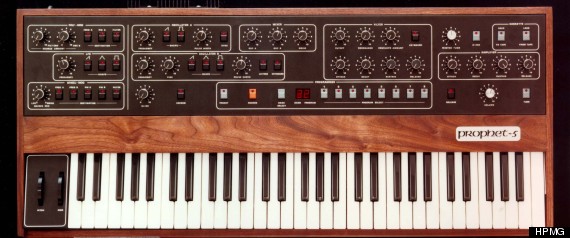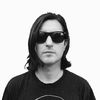In 2014, when we think of the microprocessor, we tend to think of the personal computer or cell phone. While researching the history of the microprocessor, I discovered a way in which it turned up in our culture in the most pervasive way it could have: Music.

The Prophet-5 was a synthesizer designed by Grammy Award Winner Dave Smith, an inventor and programmer, for his company Sequential Circuits. Dave Smith founded Sequential Circuits in 1978 and it became the most successful synthesizer company of its day. I see the Prophet-5 as a missing link in the great narrative of microprocessors and ultimately the personal computer revolution. The following is an interview I conducted with Mr. Smith.
MN: When creating the Prophet-5, what inspired you to insert microprocessor technology into the synthesizer?
DS: In the early 70's, I worked at Signetics (now owned by Philips) in microprocessor development. My next job was at Diablo Systems (owned by Xerox) using microprocessors to control printers and computer terminals. So, to me using a microprocessor in the design of the Prophet-5 was obvious. It allowed all the synth control logic to be handled in firmware rather than hardware, making it much easier and faster to design, and greatly simplified the schematics. A programmable/polyphonic synth would have been very difficult, buggy, and expensive to do otherwise.
MN: In 1977, what microprocessors were available to you? Were you aware of what was happening in the world of personal computing?
DS: The Intel 8080 was very popular, and I had used it in designs at Diablo Systems but, it required 3 power supplies and a number of different interface chips in a typical system. The Zilog Z80 was newer and did not have these problems, and was reasonably inexpensive and very easy to use, so it was an obvious choice. It's funny; when I started Sequential Circuits in 1974, one product idea I had was to connect a microprocessor to a keyboard, floppy drive, and CRT to make a simple computer. Likely, a bunch of people had that same idea around the same time, and I was much more interested in musical products.
MN: I read that you worked with such diverse talents as Bernie Worrell and Keith Emerson. What are some of the most surprising works that artists have created with the Prophet-5 that could not have been produced otherwise?
DS: Since the P5 was the first of its kind, pretty much everyone used it starting in 1978, and so it's a very long list. Pink Floyd's The Wall comes to mind, as well as many albums from Michael Jackson, Genesis, Abba, Peter Gabriel, John Lennon, Talking Heads, etc. And, they are still used in many modern recordings today, 35 years later.
The P5 was used in pop music, jazz, experimental, country, electronic, and other musical styles. It was very popular in movie soundtracks, since now a single musician could quickly cover a wide range of both musical styles and sound effects with a single instrument. There were controversies with unions that synths were now putting musicians out of work; one synth player could easily replace a small orchestra in the studio. This was not the case when synths were non-programmable and monophonic, so we can blame the P5! We also introduced micro-tuning on later versions, which enabled musicians (Terry Riley comes to mind) to utilize alternate tunings in their compositions.
MN: What were some of the characteristics of the Prophet-5 that pushed the rest of your competitors to get into microprocessor technology?
DS: It was simply the fact that it was completely programmable and polyphonic, and the only logical way to design such an instrument was with a microprocessor. They all understood this once they saw the Prophet-5. As a side note, once you have a microprocessor in an instrument, you realize that it's very easy to have them digitally communicate with one another. So, at Sequential we designed a simple digital serial interface so our products could talk to each other. Other companies soon did the same with their products. Eventually we realized it was a problem that instruments from different companies could not connect, which led to the development of MIDI, which I spearheaded starting in 1981. No microprocessor, no MIDI.
MN: I understand that you have designed many more influential synthesizers and won numerous awards for them. As someone on the front line of synthesizer design, what are your thoughts about the permanent marriage between high tech and musical instruments as we go forward?
DS: Well, synths only exist as high-tech musical instruments. At this point, they have passed the test of time: the basic analog subtractive synthesizer design has been around for 50 years, and has a very recognizable sound that everyone can recognize There are many versions: simple hardware monophonic non-programmable instruments, the polyphonic programmables starting with the P5, digital emulations, software emulations, etc. The P5 was the instrument that took these synths from being a hard-to-use and complex specialty product to a product for mainstream musicians.
MN: Lastly, Have you ever considered yourself a hardware hacker?
DS: Maybe a little. In high school I remember modifying amps to make distorted sounds, and building speakers, simple stuff. I jumped from that to designing accessories from for my own synth in the early 70's. I suppose there is a fine line between hacking and designing at that level, but once I started designing complete instruments, there was certainly no hacking involved!
Here's a short incomplete list of musicians who have made important records with the Prophet-5: Laurie Anderson, The Teardrop Explodes, Soft Cell, Arthur Brown, Kate Bush, Devo, Tangerine Dream, Peter Gabriel, Phillip Glass, Hall and Oates, Talking Heads, INXS, Japan, Rick James, Giorgio Morodor, Kraftwerk, Anton LeVey, Lene Lovich, Mad Professor, New Order, Gary Numan, Michael Schenker Group, Frontline Assembly, The Orb, Public Image Ltd., Duran Duran, Todd Rundgren, Ryuchi Sakamoto, David Sylvian, Ultravox, Vangelis, Rick Wakeman, Pink Floyd, XTC, Joe Zawinul.
